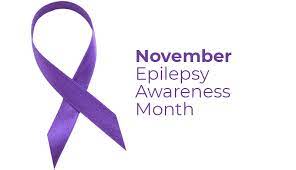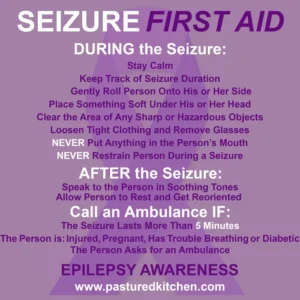**With how long it can take a ambulance to get to their destination and than get the pt to the hospital I recommend CALL 911 Immediately if never diagnosed before or if diagnosed with after 1 minute or so in the seizure. Since the braisn can die with NO oxygen in 7 seconds. Keep in mind the person in a seizure does not mean they have no oxygen immediately but status epilepticus (one seizure after another) going on minutes can cause that condition. John Travolta’s son died due to a blood disorder caused Kawasaki Disorder and the son was taken off epileptic medications 1 wk by the parents but no fault on that was proven as the reason for the child’s death by coroner’s report.
Seizures vary from person to person depending on what type of epilepsy they have. A seizure occurs when normal signals in the brain are interrupted. With epilepsy, it is usually a burst of abnormal brain activity that causes the disruption. There are many different types of epileptic seizures.
Types of epileptic seizures:
Remember epileptic seizures vary from person to person and their are many different factors that could have caused it.
Recently in 2017, there was a new system established to describe the different types of seizures, aimed at making it clearer for doctors to notice and understand the onset and characteristics of different seizures and treat them effectively. It is still quite complex, but the types are named based on 3 characteristics:
- Where in the brain the seizure begins, whether it is on 1 or both sides of the brain, and another factor is how much of the brain is affected, a localized area or 1/2 the brain or the entire brain. Generalized seizures usually affect both sides, while a focal seizures affects a portion of the brain.
- How aware the person is during the seizure, partially or entirely unconscious.
- How much movement, or ‘jerking’ there is during the seizure
Tonic clonic seizures
These are the ones most people think of when they think of fits, that people use to call them. They affect both sides of the brain and are therefore generalized seizures, the person will not be aware during the seizure and may not remember it at all, and there is considerable movement. This also used to be known as a ‘grand mal’ seizure. A person will become suddenly stiff, then usually collapse, after which the muscles will tense and relax rhythmically. This can cause shaking, grunting, foaming at the mouth, and biting as the person has no control over the muscles in the body. The person is unconcious.
Tonic and atonic seizures
A tonic seizure involves all the muscles suddenly becoming stiff, but doesn’t have the repetitive tensing and relaxing. An atonic seizure is the opposite, where all the muscles suddenly relax and the body goes floppy. Both these types are usually very quick and the body will probably fall over, and both are considered generalized seizures affecting both sides of the brain. Again the person is unconcious.
Clonic seizures
Clonic seizures involve the rhythmical jerking without the initial stiffening of the muscles. They can be generalized, affecting the whole body, or focal, where only one side of the body is affected. The
Myoclonic seizures
These are smaller jerking movements, similar to the feelings some people get when falling asleep. They can happen in clusters, with a series of jerks all at once. Although the person is conscious throughout, these are considered generalized seizures, as they are usually accompanied by other generalized seizures and often affect both sides of the brain.
Absence seizures
These generalized seizures are more common in children, and involve temporary absences, almost like daydreaming. The person may miss pieces of information in a conversation, all of a sudden garbled words – not making any sense and may blink rapidly or stare into space. You snap your fingers in front the person’s eyes and no response of the person till they come out of the seizure. The person is unconcious temporarily.
Focal onset aware seizures
A focal seizure begins in 1 part of the brain rather than both sides or the entire brain being affected, and as such rarely involves jerking or convulsions. Focal aware seizures occur when the person is aware and not unconcious of what is going on, but may feel a strange sensation. This can be an upset stomach, a wave going through the body, or deja vu, among many other things. They are often undetectable to anyone else, although can sometimes involve movement such as lip smacking or noises.
Focal onset impaired seizures
These similarly only affect a part of the brain, but they leave the person impaired in some way. They may be confused, have a loss of memory, or be unable to communicate or understand. Recovery periods can vary as well, with some needing to sleep or rest afterwards, while others recover almost immediately.
Focal to bilateral tonic clonic seizures
Focal seizures can sometimes spread to the whole brain, resulting in a tonic clonic seizure.
Unknown onset seizures
Sometimes the origin of the seizure is unknown, usually because the seizure was not seen by anyone else or occurred during sleep. This is then called an unknown onset seizure, and future seizures may help to understand more about this person’s epilepsy.
As you can see there are many different types of epileptic seizures that occur for many different reasons as well, and within this many symptoms or possible reactions for the body and brain. We will cover causes and symptoms this week in one of our topis for epilepsy. Understanding the type of seizure with how a seizure starts and how a person behaves while having a seizure can help determine how best to treat the epilepsy. People also get to know any triggers that can cause their epileptic seizures. The most common triggers are flashing lights, stress, anxiety and sleep deprivation. As we said earlier, some people stop having seizures after a while, although the reasons behind this are as unknown as the causes for many people with epilepsy, in the first place others.

